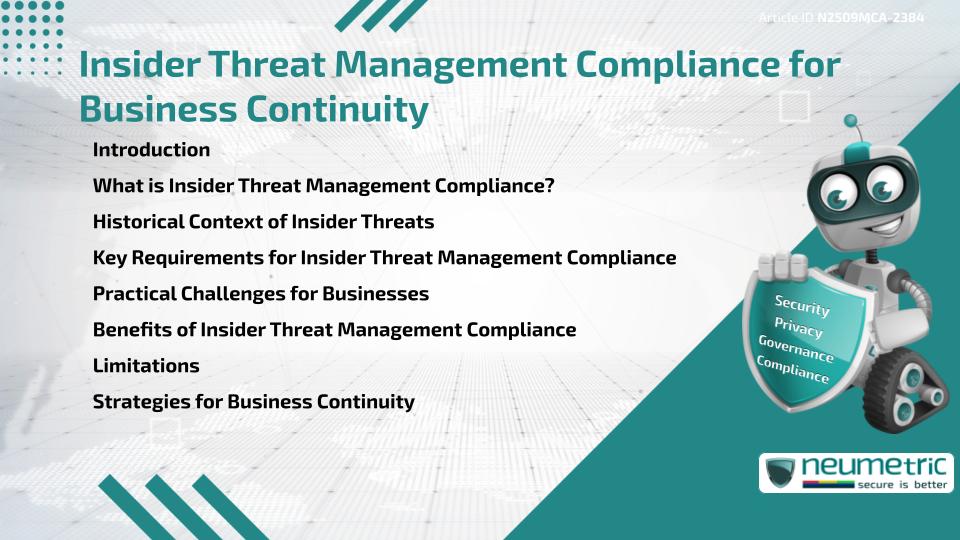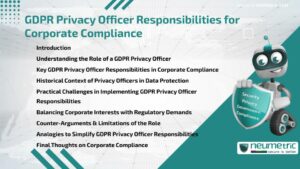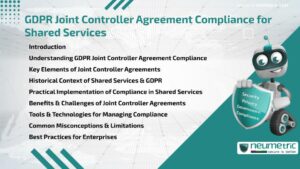Table of Contents
ToggleIntroduction
Insider Threat Management Compliance is a Critical Component of Modern Business Continuity Planning. Unlike External Cyberattacks, Insider Threats come from Employees, Contractors or Partners who misuse their access to harm the organisation. By implementing Compliance Frameworks, businesses can reduce Risks, protect Sensitive Data & Ensure Continuity of Operations.
What is Insider Threat Management Compliance?
Insider Threat Management Compliance refers to the Policies, Controls & Monitoring mechanisms organisations adopt to detect & prevent harmful Insider activities. These Frameworks align with Standards such as NIST, ISO 27001 & sector-specific Regulations. Compliance ensures businesses balance Security with Employee Privacy while demonstrating Accountability to Regulators & Stakeholders.
Historical Context of Insider Threats
Insider Threats have existed for decades, often overlooked compared to External Attacks. High-profile cases in Finance, Healthcare & Government highlighted How Insiders could Exploit trust to steal data or disrupt Operations. Over time, Regulators & Industry bodies introduced requirements for Insider Threat Programs, making Compliance part of Enterprise Governance & Resilience Strategies.
Key Requirements for Insider Threat Management Compliance
Businesses seeking Compliance should implement:
- Access Controls: Enforce Least Privilege & Monitor privileged Accounts.
- User Activity Monitoring: Track unusual behaviours through Continuous Monitoring.
- Incident Response Plans: Define Procedures for handling Insider Incidents.
- Training Programs: Educate Staff about acceptable use & reporting Suspicious Activity.
- Policy Documentation: Maintain clear Governance aligned with Regulations.
- Regular Audits: Review & Update Controls to address evolving Risks.
Practical Challenges for Businesses
Compliance is not without obstacles. Monitoring Insider activity can raise concerns about Employee Privacy. Small Businesses may lack Resources for advanced Monitoring Tools. Integrating Insider Threat Management into existing Security & Continuity Frameworks often requires Cultural & Operational change.
Benefits of Insider Threat Management Compliance
Despite these challenges, Compliance offers substantial advantages:
- Reduced Risk of Data Theft, Sabotage or Fraud
- Improved trust with Regulators, Clients & Stakeholders
- Stronger alignment with Industry & Legal requirements
- Enhanced resilience through proactive Detection & Response
- Lower Long-term costs by preventing costly Incidents & Downtime
Limitations
Some argue that Compliance Programs may foster a Culture of mistrust if not managed carefully. Strict monitoring may also create Operational inefficiencies. Additionally, Compliance Frameworks cannot prevent every Insider Threat but instead reduce the Likelihood & Impact of Incidents.
Strategies for Business Continuity
To integrate Insider Threat Management Compliance into Business Continuity, organisations should:
- Conduct Risk Assessments to identify Vulnerable areas
- Implement layered Controls combining Technology & Policies
- Establish Cross-functional teams involving HR, IT & Legal Departments
- Use Automated Tools for Anomaly Detection & Reporting
- Reference Governance Resources from OECD, World Bank & ENISA to strengthen Frameworks
Takeaways
Insider Threat Management Compliance is not just a Regulatory requirement, it is a Safeguard for Business Continuity. By embedding Controls, Training & Monitoring into Operations, businesses can reduce Risks, protect trust & maintain Resilience in the face of Insider driven disruptions.
FAQ
What is Insider Threat Management Compliance?
It is the adoption of Policies & Controls to detect & prevent harmful Insider activities.
Why is it important for Business Continuity?
It reduces Risks of Sabotage, Fraud & Data Theft that could disrupt Operations.
What challenges do Businesses face?
Challenges include balancing Security with Privacy, Resource Constraints & Cultural resistance.
What are key Compliance Requirements?
Access Controls, Monitoring, Incident Response, Training & Regular Audits.
Does Compliance eliminate Insider Threats?
No, but it significantly reduces Risks & Strengthens organisational Resilience.
References
- NIST CyberSecurity Framework
- ISO 27001 – Information Security
- OECD Privacy Guidelines
- World Bank Digital Development
- ENISA – European Union Agency for CyberSecurity
Need help for Security, Privacy, Governance & VAPT?
Neumetric provides organisations the necessary help to achieve their CyberSecurity, Compliance, Governance, Privacy, Certifications & Pentesting needs.
Organisations & Businesses, specifically those which provide SaaS & AI Solutions in the Fintech, BFSI & other Regulated sectors, usually need a CyberSecurity Partner for meeting & maintaining the ongoing Security & Privacy needs & requirements of their Enterprise Clients & Privacy conscious Customers.
SOC 2, ISO 27001, ISO 42001, NIST, HIPAA, HECVAT, EU GDPR are some of the Frameworks that are served by Fusion – a SaaS, multimodular, multitenant, centralised, automated, CyberSecurity & Compliance Management system.
Neumetric also provides Expert Services for technical Security which covers VAPT for Web Applications, APIs, iOS & Android Mobile Apps, Security Testing for AWS & other Cloud Environments & Cloud Infrastructure & other similar scopes.
Reach out to us by Email or filling out the Contact Form…





